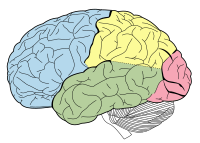
Photo from wikipedia
Brain–computer interfaces are an emerging field of medical technology that enable users to control external digital devices via brain activity. Steady-state evoked potential is a type of electroencephalogram signal that… Click to show full abstract
Brain–computer interfaces are an emerging field of medical technology that enable users to control external digital devices via brain activity. Steady-state evoked potential is a type of electroencephalogram signal that is widely used for brain–computer interface applications. Collecting electroencephalogram data is an effort-intensive task that requires technical expertise, specialised equipment, and ethical considerations. This work proposes a class-conditioned Wasserstein generative adversarial network with a gradient penalty loss for electroencephalogram data generation. Electroencephalogram data were recorded via a g.tec HiAmp using 5, 6, 7.5, and 10 Hz flashing video stimuli. The resulting model replicates the key steady-state-evoked potential features after training for 100 epochs with 25 batches of 4 s steady-state-evoked potential data. This creates a model that mimics brain activity, producing a type of symmetry between the brain’s visual reaction to frequency-based stimuli as measured by electroencephalogram and the model output.
Journal Title: Symmetry
Year Published: 2022
Link to full text (if available)
Share on Social Media: Sign Up to like & get
recommendations!